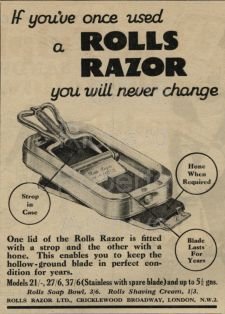Shaving – the ongoing battle between wet and electric
As part of our Heritage Open Day 2022 programme at the archive I put together a short talk on the rise of the electric razor and its impact on the traditional “wet shave” that went before. Here is a brief history of this ongoing tussle.
It is thought that shaving started as early as the Stone Age but the first positive evidence of shaving comes from 3000BC Egypt where copper and gold razors have been found in tombs.
Further evidence of shaving comes from the Roman period where the proof is shown in murals and statues created at the time. Shaving has always been subject to the vagaries of fashion and shaving has not just been restricted to men’s facial hair but to hair growing on any part of the body on men and women. Religion too has played a great part in how much or little shaving was done. The Romans used a number of shaving techniques which involved clam shells, sharpened obsidian and pumice (though I suspect rubbing pumice over your face would be quite a task). With the refinements made in steel technology the standard tool for shaving up to the 1900s was the sharpened steel blade commonly known as the “cut-throat” razor.
It is not until the late 1700s that the next major change occurred when Jean-Jacques Perret attached a wooden shield to an open cut-throat razor and thus created the first “safety razor”.
The earliest advertisement I have found in the archive is from 1893 and is for a Sprock’s safety razor of the cut-throat type (Fig. 1) which appeared in a copy of The Graphic.
1876 saw the next development of the razor with the introduction of the “Star” sharpened single-edge-blade razor. The distinctive feature here was a blade that was now separate from the razor itself. Its main disadvantage was that the blade had to be honed prior to each use and then be fastened into the holder.
Nearly twenty years later King Camp Gillette invented the double-edged detachable blade. This razor was easier to use because of its quick-release mechanism, while the need for honing was taken away as the blades were cheap enough to be thrown away after one use. (Figs. 2, 3, 4 and 5 show examples of the Gillette razor as it appeared in the 1920s and 1930s).
The first electric razor was invented by Jacob Schick in 1928 (Figs. 6 and 7 give examples from 1937). Electric razors were sold on the benefits of their ease and convenience of use. To quote a Schick advertisement: “A Schick Dry Shaver does away with soap, water, lather, blades, brush, towels, lotions and everything at “one fell swoop””.
Indeed using an electric razor is quicker and easier than a wet shave but the purist will always point out that you get a closer and better shave using a “wet” razor.
It did not take long before other manufacturers got in on the act and I have included examples from Siemens-Schuckert in 1934 (Fig. 8), Ronson in 1959 (Fig. 9), Sunbeam in 1960 (Fig. 10), Norelco in 1967 and 1992 (Figs. 11 and 12), and Braun with a battery razor in 1984 (Fig. 13).
Over the following decades this argument over quality of shave has continued, with both electric and wet razors coming up with different methods of improving the shave. Electric razors added devices for trimming while wet shavers increased the number of blades from one to the astonishing seven being touted today (the Dorco 7-blade announced in 2015).
1975 saw the introduction of the completely disposable razor by BIC, with its blade built into a hollow plastic handle.
Interestingly it was not until the 1960s that stainless steel was used for razor blades, removing the annoying problem of rust appearing on blades used more than once.
Various means of sharpening blades have appeared over the years from honing stones built into the storage box (Rolls Razor Fig. 14) to separate tools such as the “Spiro” by John Watts (Fig. 15).
To conclude this article I have included an advertisement from a few days ago for a HARRY’S grooming kit (Fig. 16).
Let me know about your most memorable shaving adverts!
















